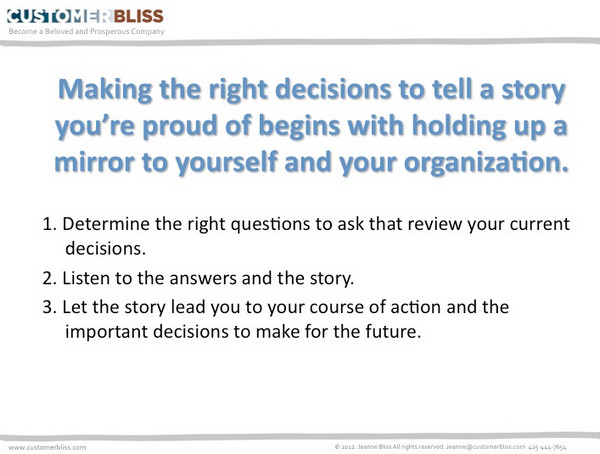This is a guest post from Jeanne Bliss — customer experience expert and author of “I Love You More Than My Dog.” See the original post this is adapted from and more like it on her blog.
Making the right decisions to tell a story you’re proud of begins with holding up a mirror to yourself and your organization.
You need to ask the right questions to review your current decisions and understand the story the decisions reveal about you today. You need to know the important decisions to make for the future.
Darwin Smith, CEO of Kimberly-Clark from 1971 through 1991, is considered by many to be one of the top ten CEOs of all time. Jim Collins, in his book Good to Great, introduced the story about how Smith moved his company from a languishing business to the world’s highest performing paper-based consumer products company, by asking questions and moving rocks.
When Smith took over the helm of Kimberly-Clark in 1971, he worked to grasp what direction to take the company. In the quiet of the evening at his Gotrocks Farm in Wisconsin, he would contemplate the situation by unearthing rocks on his property and moving them into piles. When his wife Lois heard the scrape of a backhoe in the middle of the night, she knew he was thinking over a decision. In the morning, the extent of his thinking would stand in large piles of rocks that had been moved from one pile to another as he contemplated his course of action.
Those rock moving sessions in the evening didn’t bring Smith answers; they brought him questions.
Questions he would ask his leadership team and people inside his company for months.
He wanted to know:
- What Kimberly-Clark should stand for
- What it could be known for
- How it could grow financially
The answers to his questions told Smith the story of his company.
Smith learned where Kimberly-Clark stood and what decisions and actions had been made to get the company to its current position. From those answers, Smith realized what initial actions he needed to take to move the company in a new direction. The answers to Smith’s questions led him to his first steps in leading Kimberly-Clark onto the path of its success.
Darwin Smith moved rocks to find his questions. Through this process, he accomplished three things.
- He determined the right questions to ask.
- The answers then told him the story of his company.
- That story led him to his course of action.
Connecting your answers will tell you how you are seen from the outside looking in.
The sum of your answers will reveal the story of who you are and what you value as defined by the decisions you make and the actions that tumble from them.

About Jeanne Bliss
As “Chief Customer Officer” for Lands’ End, Mazda, Coldwell Banker, Allstate, and Microsoft, Jeanne got “customer” on the strategic agenda, earned 98% loyalty rates, and changed experiences across 50,000-person operations. Jeanne now runs CustomerBliss to create an actionable path for profitability and business growth -- through earning customer and employee raves. Her best-selling books are Chief Customer Officer and I Love You More than My Dog: Five Decisions that Drive
- Web |
- More Posts(64)



Trackbacks/Pingbacks
[…] Fonte: WordofMouth.org […]